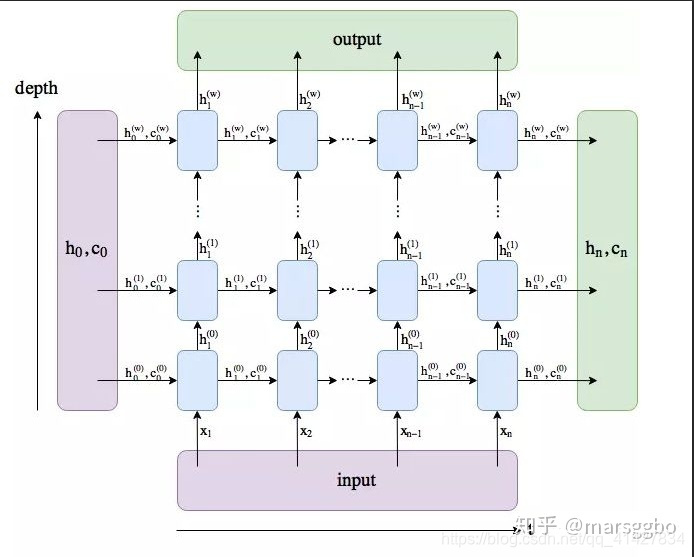
pytorch_LSTM:参数
发布日期:2022-02-17 04:52:21
浏览次数:13
分类:技术文章
本文共 6549 字,大约阅读时间需要 21 分钟。

self.lstm = nn.LSTM(input_size=n_class, hidden_size=n_hidden, num_layers=n_layers)
输入网络的维度数:26,隐层维度:128,lstm层数:n_layers:1LSTM: 单向LSTM,D=1
input:[3, 10, 26] sequence len=3, batch=10, input_size=26# 可以理解为,sequence length有多长就有几个上图中的F h0:[1, 10, 128] n_layers = 1, batch=10, hidden_size=128 c0:[1, 10, 128] n_layers = 1, batch=10, hidden_size=128 输入,3个细胞单元作为输入,每个细胞单元接收26维的输入,一个batch为10条数据输出:output, (h_n, c_n)
output: [3, 10, 128],3个细胞单元,一批次10个数据,隐层维度为128,输出最后一层每个细胞单元的隐层输出;output保存了最后一层,每个time step的输出h
h_n保存每一层,最后一个time-step的输出hc_n保存每一层,最后一个time-step的输出c 
官方给定实例:
# Examples::# 初始化模型rnn = nn.LSTM(10, 20, 2) # 输入特征的维度:10,隐层维度:20 ,LSTM层数:2# 输入数据格式input = torch.randn(5, 3, 10) # 句子长度:5,batch_size:3,输入特征的维度:10# 隐层结构h0 = torch.randn(2, 3, 20) # LSTM层:2,batch_size:3,隐层参数维度:20# 细胞单元结构c0 = torch.randn(2, 3, 20) # 同上# 输出结构output, (hn, cn) = rnn(input, (h0, c0))""" output:LSTM最后一层隐状态的输出,维度:(5, 3, 20) hn:最后一个timestep的隐状态结果,维度:(1, 3, 20) cn:最后一个timestep的细胞单元的结果,维度:(1, 3, 20)"""
BiLSTM-torch调用:
# 单层变双层,单向变为双向# 举例解决:# 单层Bilstm, 输入数据,一个batch包含26条数据,每条数据为27x27,类别数为27,每个单元包含隐藏单元为5# 定义BiLSTM时:bilstm = nn.LSTM(input_size=27, hidden_size=5, bidirectional=True)# 输入input维度应为:[sequence length, batch size, input_size]即需通过torch.transpose(0, 1)改变维度inputs shape: [27, 26, 27]# 隐藏定义:[Bilstm:2 x 层数默认:1, batch_size:26, 每个单元包含隐藏单元:5]h0 shape: [2x1, 26, 5]c0 shape: [2x1, 26, 5] #细胞状态同上output, (h_n, c_n) = bilstm(inputs, (h0, c0)#同lstm,output包含最后一层所有细胞的隐层输出,# [sequence length, batch size, H_{out}*2]output shape: [27, 26, 5*2]# h_n 包含最后一个细胞的最后一个时间步的隐层输出# [D * num_layers, batch size, H_{out}]h_n shape: [2, 26, 5]# c_n同上c_n shape: [2, 26, 5] pytorch实现LSTM例子:
import numpy as npimport torchimport torch.nn as nnfrom torch.nn.modules import loss, moduleimport torch.optim as optimdef make_batch(): input_batch, target_batch = [], [] for seq in seq_data: input = [word_dict[n] for n in seq[:-1]] #到最后一个字母 target = word_dict[seq[-1]] # 最后一个标签,预测最后一个单词 input_batch.append(np.eye(n_class)[input]) target_batch.append(target) print("input:{}, target:{}".format(input, target)) return input_batch, target_batch""" np.eye(3):代表一个维度为3的单位矩阵 np.eye(x)[N]: 代表取出维度为x的单位矩阵的第N行,用于构造one-hot表示 x.transpose(0, 1):交换0,1两个维度 例:x为[10, 3, 26] x.transpose(0, 1)为[3, 10 ,26] # 有啥意义 Examples:: >>> rnn = nn.LSTM(10, 20, 2) # input_size: The number of expected features in the input `x` hidden_size: The number of features in the hidden state `h` num_layers: Number of recurrent layers. E.g., setting ``num_layers=2`` >>> input = torch.randn(5, 3, 10) : N,L,H_{in}或L,N,H_{in} 输入向量的长度, 一次传入多少条数据,单词向量的维度 L ={} & \text{sequence length} \\ N ={} & \text{batch size} \\ H_{in} ={} & \text{input\_size} \\ >>> h0 = torch.randn(2, 3, 20) (D * \text{num\_layers}, N, H_{out}), BiLSTM: D=2, LSTM: D=1 H_{out} ={} & \text{proj\_size if } \text{proj\_size}>0 \text{ otherwise hidden\_size} \\\end{aligned} >>> c0 = torch.randn(2, 3, 20) (D * \text{num\_layers}, N, H_{cell}) H_{cell} ={} & \text{hidden\_size} \\ >>> output, (hn, cn) = rnn(input, (h0, c0)) output保存了最后一层,每个time step的输出h,如果是双向LSTM,每个time step的输出h = [h正向, h逆向] (同一个time step的正向和逆向的h连接起来)。 h_n保存了每一层,最后一个time step的输出h,如果是双向LSTM,单独保存前向和后向的最后一个time step的输出h。 c_n与h_n一致,只是它保存的是c的值。 output是一个三维的张量,第一维表示序列长度,第二维表示一批的样本数(batch),第三维是 hidden_size(隐藏层大小) * num_directions """class TextLSTM(nn.Module): def __init__(self): super(TextLSTM, self).__init__() self.lstm = nn.LSTM(input_size=n_class, hidden_size=n_hidden) # input_size:26 # hidden_size:128 # mode:'LSTM' # num_layers:1 self.W = nn.Linear( n_hidden, n_class, bias=False ) #LSTM+一个线性层加偏置,最后softmax输出 # out_features:26 # in_features:128 self.b = nn.Parameter(torch.ones( [n_class])) # P的大小写有何影响,nn.parameter报错,必须得是nn.Parameter def forward(self, x): # print('x:{}, x_size:{}'.format( # x, x.size())) # shape:torch.Size([10, 3, 26]) input = x.transpose(0, 1) # torch.Size([3, 10, 26]) ****有何意义 # print('input:{}, input_size:{}'.format(input, input.size())) hidden_state = torch.zeros(1, len(x), n_hidden) # shape:torch.Size([1, 10, 128]) cell_state = torch.zeros(1, len(x), n_hidden) # shape:torch.Size([1, 10, 128]) # 为啥少了一个维度啊???? outputs, (_, _) = self.lstm(input, (hidden_state, cell_state)) # _1,2: torch.Size([1, 10, 128]) # print("outputs_size:{}".format( # outputs.size())) # torch.Size([3, 10, 128]) outputs = outputs[-1] # outputs: torch.Size([10, 128]) # 使用outputs的原因:保留最后一层所有隐层的输出,可以尽可能包含所有的局部信息,减少RNN的梯度消失、最后输出的向量与较后的cell有关 model = self.W( outputs ) + self.b # shape:torch.Size([10, 26]) batch_size, n_class # print("model:{}".format(model)) return modelif __name__ == '__main__': n_step = 3 n_hidden = 128 char_arr = [c for c in 'abcdefghijklmnopqrstuvwxyz'] word_dict = {w: i for i, w in enumerate(char_arr)} number_dict = {i: w for i, w in enumerate(char_arr)} print(number_dict) # print(word_dict) n_class = len(word_dict) seq_data = [ 'make', 'need', 'coal', 'word', 'love', 'hate', 'live', 'home', 'hash', 'star' ] model = TextLSTM() criterion = nn.CrossEntropyLoss() optimizer = optim.Adam(model.parameters(), lr=0.001) input_batch, target_batch = make_batch() # 原本shape[10, 3], [10] input_batch = torch.FloatTensor( input_batch ) # shape:torch.Size([10, 3, 26]) 10条数据,每条数据长度为3,one-hot表示维度为26 target_batch = torch.LongTensor(target_batch) for epoch in range(1000): optimizer.zero_grad() output = model(input_batch) loss1 = criterion(output, target_batch) if (epoch + 1) % 100 == 0: print('Epoch:', '%04d' % (epoch + 1), 'cost =', '{:.6f}'.format(loss1)) loss1.backward() optimizer.step() inputs = input_batch[:4] # inputs = inputs.unsqueeze(0) print('inputs:{}, inputs_size:{}'.format(inputs, np.shape(inputs))) print("mdoel:{}".format(model)) #model就是一个输入26维,输出128维的lstm print("mdoel(inputs):{}".format(model(inputs))) predict = model(inputs).data.max(1, keepdim=True)[1] # output = model(input_batch) print("predict:{}".format(predict)) 转载地址:https://blog.csdn.net/qq_41427834/article/details/119826709 如侵犯您的版权,请留言回复原文章的地址,我们会给您删除此文章,给您带来不便请您谅解!
发表评论
最新留言
哈哈,博客排版真的漂亮呢~
[***.90.31.176]2024年04月11日 17时12分29秒
关于作者

喝酒易醉,品茶养心,人生如梦,品茶悟道,何以解忧?唯有杜康!
-- 愿君每日到此一游!
推荐文章
LeetCode题解(1508):子数组和排序后的区间和(Python)
2019-04-26
LeetCode题解(1509):三次操作后最大值与最小值的最小差(Python)
2019-04-26
LeetCode题解(1510):石子游戏IV(Python)
2019-04-26
LeetCode题解(1497):检查数组对是否可以被k整除(Python)
2019-04-26
LeetCode题解(0781):森林中的兔子(Python)
2019-04-26
LeetCode题解(0930):和相同的二元子数组(Python)
2019-04-26
LeetCode题解(0939):最小面积矩形(Python)
2019-04-26
LeetCode题解(0954):二倍数对数组(Python)
2019-04-26
LeetCode题解(0957):N天后的牢房(Python)
2019-04-26
LeetCode题解(0974):和可被K整除的子数组(Python)
2019-04-26
LeetCode题解(0981):基于时间的键值存储(Python)
2019-04-26
LeetCode题解(0992):K个不同呢的子数组(Python)
2019-04-26
LeetCode题解(1001):网格照明(Python)
2019-04-26
LeetCode题解(1044):最长重复子串(Python)
2019-04-26
LeetCode题解(1048):最长字符串链(Python)
2019-04-26
LeetCode题解(1072):按列翻转得到最大值等行数(Python)
2019-04-26
LeetCode题解(1086):前五科的均分(Python)
2019-04-26
LeetCode题解(1364):顾客的可信联系人数量(SQL)
2019-04-26
LeetCode题解(1369):获取最近第二次的活动(SQL)
2019-04-26
LeetCode题解(1378):使用唯一标识码替换员工ID(SQL)
2019-04-26